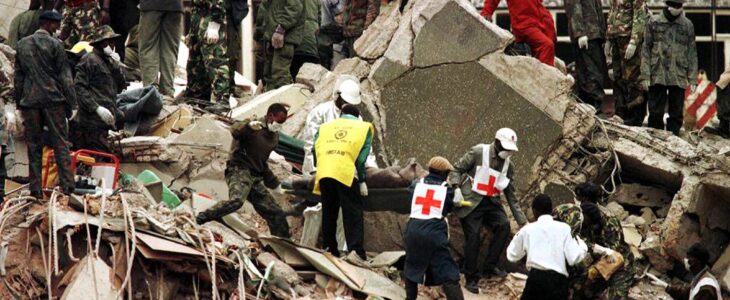
Al-Qaida’s second-highest leader, accused of being one of the masterminds of the deadly 1998 attacks on U.S. embassies in Africa, was killed in Iran three months ago, intelligence officials have confirmed.
Abdullah Ahmed Abdullah, who went by the nom de guerre Abu Muhammad al-Masri, was gunned down on the streets of Tehran by two assassins on a motorcycle on Aug. 7, the anniversary of the embassy attacks. He was killed along with his daughter, Miriam, the widow of Osama bin Laden’s son Hamza bin Laden.

The attack was carried out by Israeli operatives at the behest of the United States, according to four of the officials. It is unclear what role if any was played by the United States, which had been tracking the movements of al-Masri and other Qaida operatives in Iran for years.
Sign up for The Morning newsletter from the New York Times

The killing occurred in such a netherworld of geopolitical intrigue and counterterrorism spycraft that al-Masri’s death had been rumored but never confirmed until now. For reasons that are still obscure, al-Qaida has not announced the death of one of its top leaders, Iranian officials covered it up, and no country has publicly claimed responsibility for it.
Al-Masri, who was about 58, was one of al-Qaida’s founding leaders and was thought to be first in line to lead the organization after its current leader, Ayman al-Zawahri.
Long featured on the FBI’s Most Wanted Terrorist list, he had been indicted in the United States for crimes related to the bombings of the U.S. embassies in Kenya and Tanzania, which killed 224 people and wounded hundreds. The FBI offered a $10 million reward for information leading to his capture, and as of Friday, his picture was still on the Most Wanted list.
That he had been living in Iran was surprising, given that Iran and al-Qaida are bitter enemies. Iran, a Shiite Muslim theocracy, and al-Qaida, a Sunni Muslim jihadi group, have fought each other on the battlefields of Iraq and other places.
American intelligence officials say that al-Masri had been in Iran’s “custody” since 2003, but that he had been living freely in the Pasdaran district of Tehran, an upscale suburb, since at least 2015.
Around 9 on a warm summer night, he was driving his white Renault L90 sedan with his daughter near his home when two gunmen on a motorcycle drew up beside him. Five shots were fired from a pistol fitted with a silencer. Four bullets entered the car through the driver’s side and a fifth hit a nearby car.
As news of the shooting broke, Iran’s official news media identified the victims as Habib Daoud, a Lebanese history professor, and his 27-year-old daughter Maryam. The Lebanese news channel MTV and social media accounts affiliated with Iran&aposs Revolutionary Guard reported that Daoud was a member of Hezbollah, the Iranian-backed militant organization in Lebanon.
It seemed plausible.
The killing came amid a summer of frequent explosions in Iran, mounting tensions with the United States, days after an enormous explosion in the port of Beirut and a week before the U.N. Security Council was to consider extending an arms embargo against Iran. There was speculation that the killing may have been a Western provocation intended to elicit a violent Iranian reaction in advance of the Security Council vote.
And the targeted killing by two gunmen on a motorcycle fit the modus operandi of previous Israeli assassinations of Iranian nuclear scientists. That Israel would kill an official of Hezbollah, which is committed to fighting Israel, also seemed to make sense, except for the fact that Israel had been consciously avoiding killing Hezbollah operatives so as not to provoke a war.
In fact, there was no Habib Daoud.
Several Lebanese with close ties to Iran said they had not heard of him or his killing. A search of Lebanese news media found no reports of a Lebanese history professor killed in Iran last summer. And an education researcher with access to lists of all history professors in the country said there was no record of a Habib Daoud.
One of the intelligence officials said that Habib Daoud was an alias Iranian officials gave al-Masri and the history teaching job was a cover story. In October, the former leader of Egypt’s Islamic Jihad, Nabil Naeem, who called al-Masri a longtime friend, told the Saudi news channel Al-Arabiya the same thing.
Iran may have had good reason for wanting to hide the fact that it was harboring an avowed enemy, but it was less clear why Iranian officials would have taken in the Qaida leader to begin with.
Some terrorism experts suggested that keeping Qaida officials in Tehran might provide some insurance that the group would not conduct operations inside Iran. American counterterrorism officials believe Iran may have allowed them to stay to run operations against the United States, a common adversary.
It would not be the first time that Iran had joined forces with Sunni militants, having supported Hamas, Palestinian Islamic Jihad and the Taliban.
“Iran uses sectarianism as a cudgel when it suits the regime, but is also willing to overlook the Sunni-Shia divide when it suits Iranian interests,” said Colin P. Clarke, a counterterrorism analyst at the Soufan Center.
Iran has consistently denied housing the Qaida officials. In 2018, the Foreign Ministry spokesman Bahram Ghasemi said that because of Iran’s long, porous border with Afghanistan, some Qaida members had entered Iran, but they had been detained and returned to their home countries.
However, Western intelligence officials said the Qaida leaders had been kept under house arrest by the Iranian government, which then made at least two deals with al-Qaida to free some of them in 2011 and 2015.
Although al-Qaida has been overshadowed in recent years by the rise of the Islamic State, it remains resilient and has active affiliates around the globe, a U.N. counterterrorism report issued in July concluded.
Iranian officials did not respond to a request for comment for this article. Spokesmen for the Israeli prime minister’s office and the Trump administration’s National Security Council declined to comment.
Al-Masri was a longtime member of al-Qaida’s highly secretive management council, along with Saif al-Adl, who was also held in Iran at one point. The pair, along with Hamza bin Laden, who was being groomed to take over the organization, were part of a group of senior Qaida leaders who sought refuge in Iran after the 9/11 attacks on the United States forced them to flee Afghanistan.
According to a highly classified document produced by the U.S. National Counterterrorism Center in 2008, al-Masri was the “most experienced and capable operational planner not in U.S. or allied custody.” The document described him as the “former chief of training” who “worked closely” with al-Adl.
In Iran, al-Masri mentored Hamza bin Laden, according to terrorism experts. Hamza bin Laden later married al-Masri’s daughter, Miriam.
“The marriage of Hamza bin Ladin was not the only dynastic connection Abu Muhammad forged in captivity,” Ali Soufan, a former FBI agent and Qaida expert, wrote in a 2019 article for West Point’s Combating Terrorism Center.
Another of al-Masri’s daughters married Abu al-Khayr al-Masri, no relation, a member of the management council. He was allowed to leave Iran in 2015 and was killed by a U.S. drone strike in Syria in 2017. At the time, he was the second-ranking Qaida official after Zawahri.
Hamza and other members of the bin Laden family were freed by Iran in 2011 in exchange for an Iranian diplomat abducted in Pakistan. Last year, the White House said Hamza bin Laden had been killed in a counterterrorism operation in the Afghanistan-Pakistan region.
Abu Muhammad al-Masri was born in Al Rarbiya district of northern Egypt in 1963. In his youth, according to affidavits filed in lawsuits in the United States, he was a professional soccer player in Egypt’s top league. After the Soviet invasion of Afghanistan in 1979, he joined the jihadi movement that was coalescing to assist the Afghan forces.
After the Soviets withdrew 10 years later, Egypt refused to allow al-Masri to return. He remained in Afghanistan where he eventually joined bin Laden in the group that was later to become the founding nucleus of al-Qaida. He was listed by the group as the seventh of its 170 founders.
In the early 1990s, he traveled with bin Laden to Khartoum, Sudan, where he began forming military cells. He also went to Somalia to help the militia loyal to Somali warlord Mohamed Farrah Aidid. There he trained Somali guerrillas in the use of shoulder-borne rocket launchers against helicopters, training they used in the 1993 battle of Mogadishu to shoot down a pair of U.S. helicopters in what is now known as the Black Hawk Down attack.
“When al-Qaida began to carry out terrorist activities in the late 1990s, al-Masri was one of the three of bin Laden’s closest associates, serving as head of the organization’s operations section,” said Yoram Schweitzer, head of the Terrorism Project of the Institute for National Security Studies in Tel Aviv. “He brought with him know-how and determination and since then was involved in a large part of the organization’s operations, with an emphasis on Africa.”
Shortly after the Mogadishu battle, bin Laden put al-Masri in charge of planning operations against U.S. targets in Africa. Plotting a dramatic, ambitious operation that, like the 9/11 attacks, would command international attention, they decided to attack two relatively well-defended targets in separate countries simultaneously.
Shortly after 10:30 a.m. on Aug. 7, 1998, two trucks packed with explosives pulled up in front of the U.S. embassies in Nairobi, Kenya, and Dar es Salaam, Tanzania. The blasts incinerated people nearby, blew walls off buildings and shattered glass for blocks around.
In 2000, al-Masri became one of the nine members of al-Qaida’s governing council and headed the organization’s military training.
He also continued to oversee Africa operations, according to a former Israeli Intelligence official, and ordered the attack in Mombasa, Kenya, in 2002 that killed 13 Kenyans and three Israeli tourists.
By 2003, al-Masri was among several Qaida leaders who fled to Iran which, although hostile to the group, seemed out of American reach.
“They believed the United States would find it very difficult to act against them there,” Schweitzer said. “Also because they believed that the chances of the Iranian regime doing an exchange deal with the Americans that would include their heads were very slim.”
Al-Masri was one of the few high-ranking members of the organization to survive the American hunt for the perpetrators of 9/11 and other attacks. When he and other Qaida leaders fled to Iran, they were initially kept under house arrest.
In 2015, Iran announced a deal with al-Qaida in which it released five of the organization’s leaders, including al-Masri, in exchange for an Iranian diplomat who had been abducted in Yemen.
Abdullah’s footprints faded away, but according to one of the intelligence officials, he continued to live in Tehran, under the protection of the Revolutionary Guards and later the Ministry of Intelligence and Security. He was allowed to travel abroad and did, mainly to Afghanistan, Pakistan and Syria.
Some American analysts said al-Masri’s death would sever connections between one of the last original Qaida leaders and the current generation of Islamist militants, who have grown up after bin Laden’s 2011 death.
“If true, this further cuts links between old-school al-Qaida and the modern jihad,” said Nicholas J. Rasmussen, a former director of the National Counterterrorism Center. “It just further contributes to the fragmentation and decentralization of the al-Qaida movement.”
—
TIMELINE
1963
Abu Muhammad al-Masri was born in northern Egypt, and grew up to play soccer in Egypt’s top professional league. After the Soviet invasion of Afghanistan, he joined the jihad movement there.
1980s
After the Soviets withdrew, Egypt refused to allow al-Masri to return. He remained in Afghanistan, and eventually joined Osama bin Laden in a group that was later to become the nucleus of al-Qaida.
EARLY 1990s
Al-Masri traveled with bin Laden to Khartoum, Sudan, where he began forming military cells. He also went to Somalia, where he helped train the fighters who fought U.S. troops in a battle popularly known as the Black Hawk Down attack.
1998
Al-Masri was one of the masterminds of the deadly attacks on U.S. embassies in Nairobi, Kenya, and Dar es Salaam, Tanzania.
2000
Al-Masri became one of the nine members of al-Qaida’s governing council and was put in charge of the organization’s military training activities.
2002
While overseeing African operations, he issued orders for the attacks in Mombasa, Kenya, that killed 15 people, according to a former Israeli Intelligence official.
2003
After the 9/11 attacks, al-Masri was among several Qaida leaders who fled to Iran. They were initially held under house arrest.
2015
Iran and al-Qaida announced a deal in which Iran released five of the organization’s leaders, including al-Masri, from prison in exchange for an Iranian diplomat who had been abducted in Yemen.
2020
Al-Masri was secretly assassinated in Tehran at the behest of the U.S., officials said. But no one — Iran, al-Qaida, the U.S. or Israel — publicly acknowledged the killing.
Credit: Yahoo News
